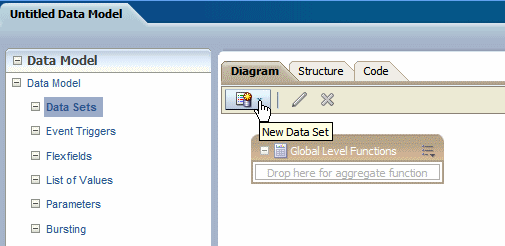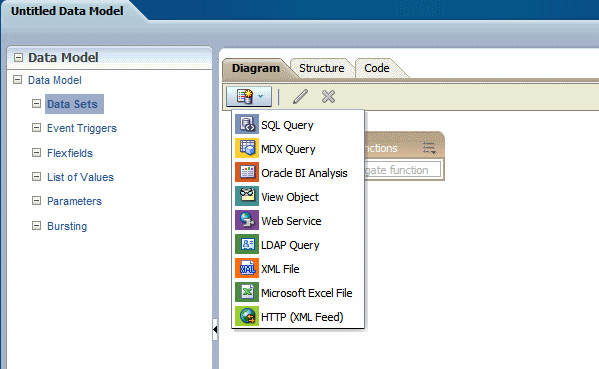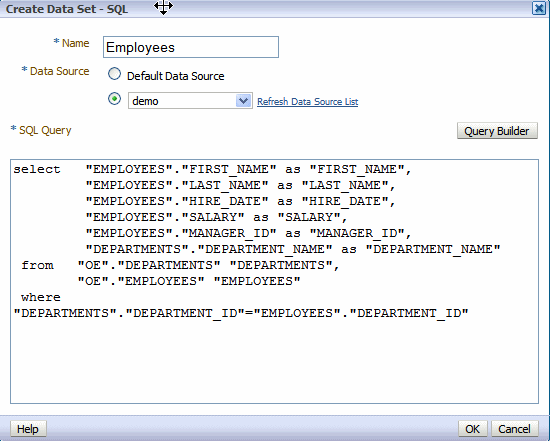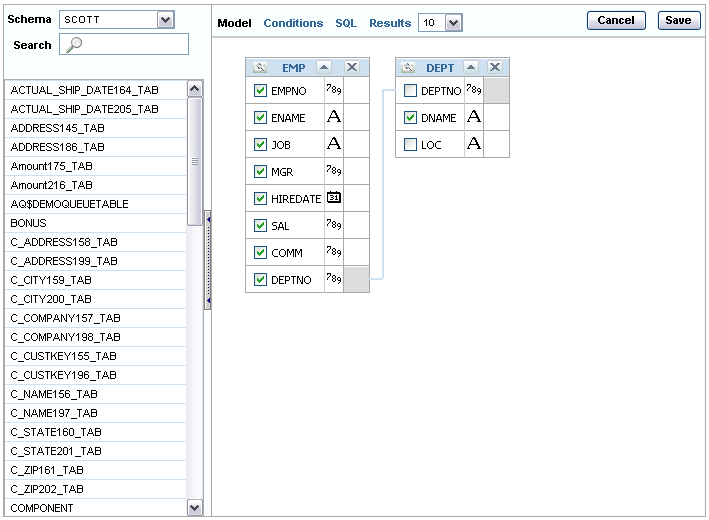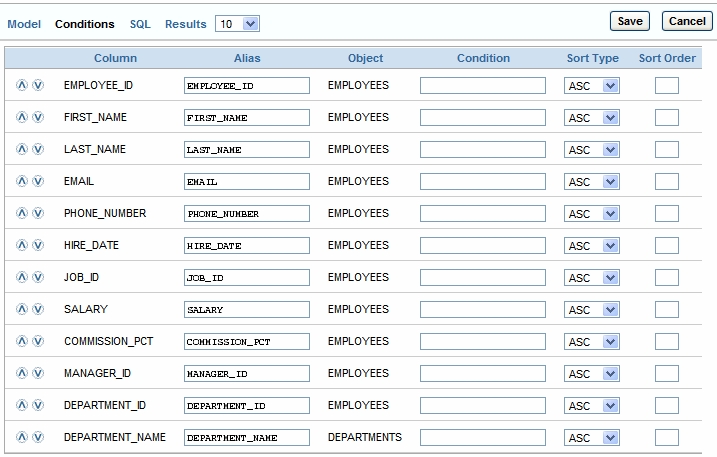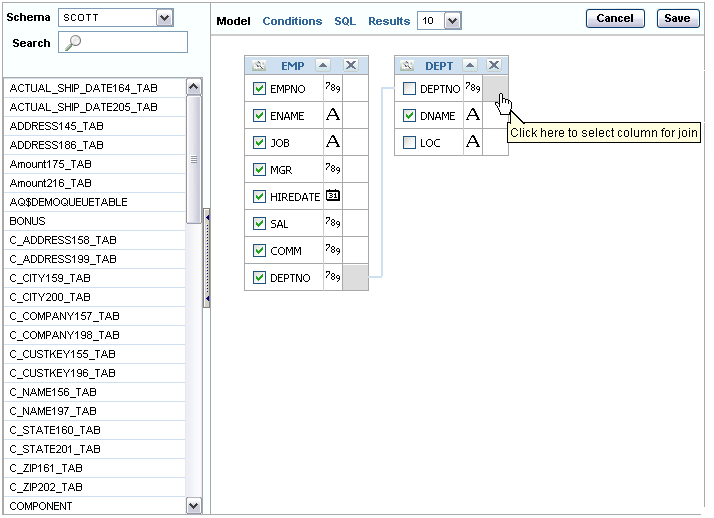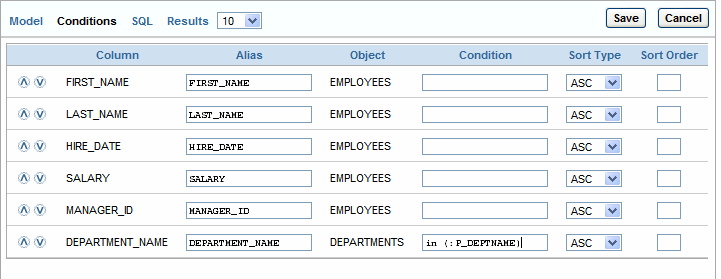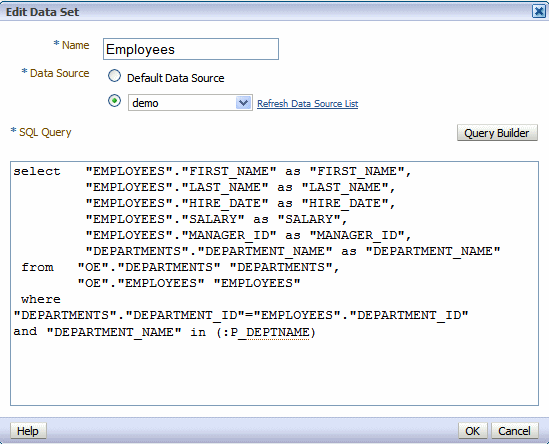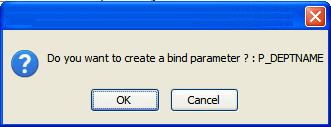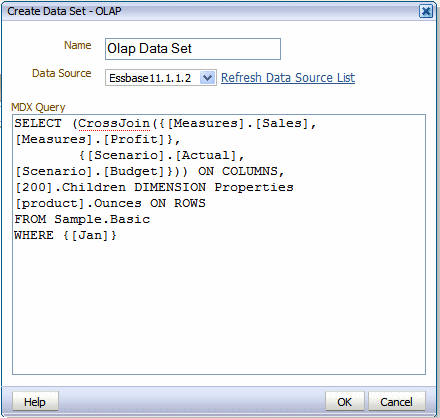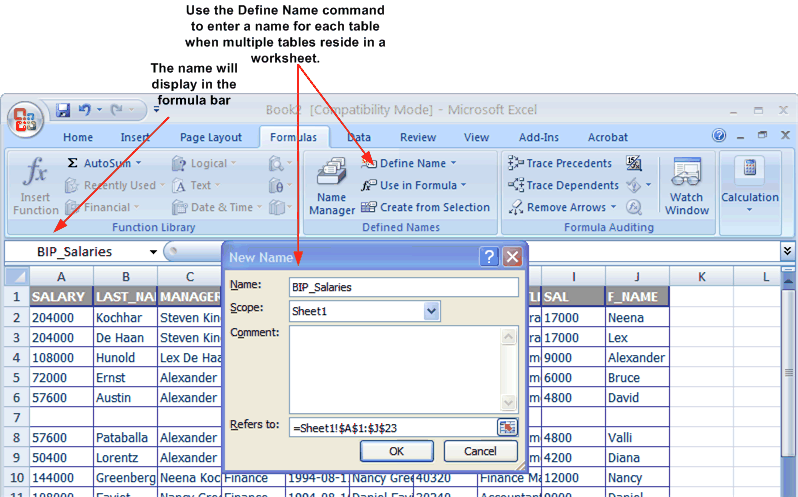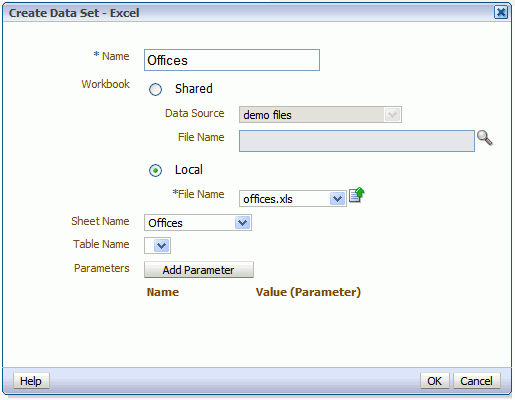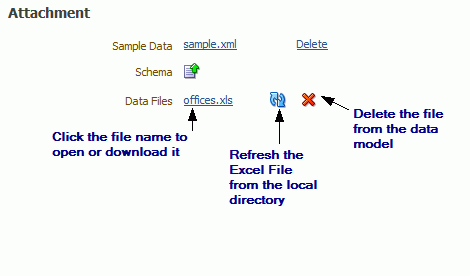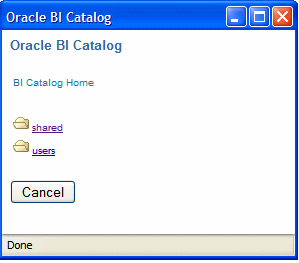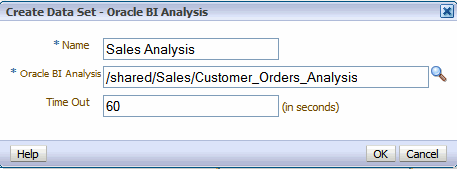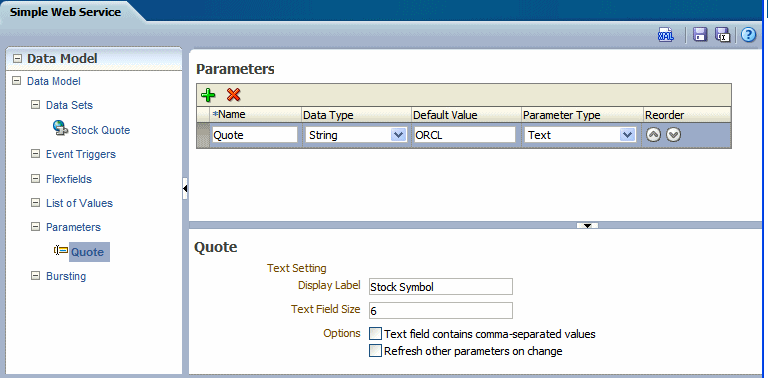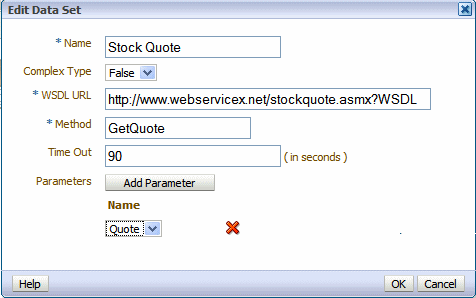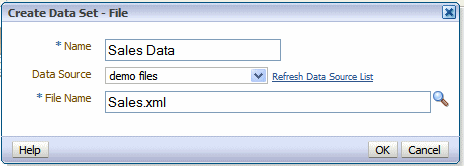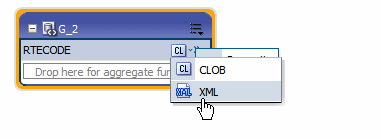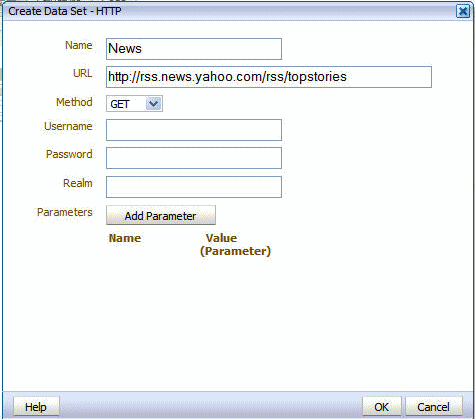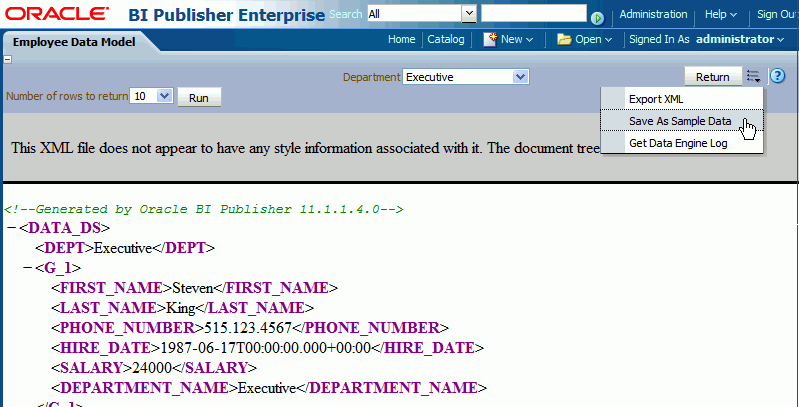2 Creating Data Sets
This chapter describes creating data sets in BI Publisher. Data sets can be created from a variety of sources including SQL queries, MDX queries, LDAP queries, Microsoft Excel worksheets, Web services, and XML files. This chapter also describes how to test your data models and save sample data.
This chapter includes the following sections:
-
Section 2.5, "Creating a Data Set Using an MDX Query Against an OLAP Data Source"
-
Section 2.7, "Creating a Data Set Using a Microsoft Excel File"
-
Section 2.8, "Creating a Data Set Using an Oracle BI Analysis"
-
Section 2.12, "Using Data Stored as a Character Large Object (CLOB) in a Data Model"
-
Section 2.14, "Testing Data Models and Generating Sample Data"
-
Section 2.15, "Including User Information Stored in System Variables in Your Report Data"
2.1 Overview of Creating Data Sets
Oracle BI Publisher can retrieve data from multiple types of data sources.
-
On the component pane of the data model editor click Data Sets.
-
Click New Data Set as shown in Figure 2-1.
-
Select the data set type from the list to launch the appropriate dialog, as shown in Figure 2-2.
-
Complete the required fields to create the data set. See the corresponding section in this chapter for information on creating each data set type.
2.2 Editing an Existing Data Set
-
On the component pane of the data model editor click Data Sets. All data sets for this data model display in the working pane.
-
Click the data set to edit.
-
Click the Edit toolbar button. The dialog for the data set opens. For information about each type of data set, see the corresponding section in this chapter.
-
Make changes to the data set and click OK.
-
Save the data model.
-
Test your edited data model and add new sample data. See Section 2.14, "Testing Data Models and Generating Sample Data."
2.3 Creating a Data Set Using a SQL Query
To create a data set using a SQL query:
-
Click the New Data Set icon and then click SQL Query. The Create Data Set - SQL dialog launches, as shown in Figure 2-3.
-
Enter a name for this data set.
-
The Data Source defaults to the Default Data Source you selected on the Properties page. If you are not using the default data source for this data set, select the Data Source from the list.
-
Enter the SQL query or select Query Builder. See Section 2.4, "Using the Query Builder" for information about the Query Builder utility.
-
If you are using Flexfields, bind variables, or other special processing in your query, edit the SQL returned by the Query Builder to include the required statements.
Note:
If you include lexical references for text that you embed in a SELECT statement, then you must substitute values to get a valid SQL statement.
-
After entering the query, click OK to save. The data model editor validates the query.
If your query includes a bind variable, you are prompted to create the bind parameter. Click OK to have the data model editor create the bind parameter. To edit the parameter, see Chapter 4, "Adding Parameters and Lists of Values."
2.4 Using the Query Builder
Use the Query Builder to build SQL queries without coding. The Query Builder enables you to search and filter database objects, select objects and columns, create relationships between objects, and view formatted query results with minimal SQL knowledge.
The Query Builder page is divided into two sections:
-
Object Selection pane contains a list of objects from which you can build queries. Only objects in the current schema display.
-
Design and output pane consists of four tabs:
-
Model — Displays selected objects from the Object Selection pane.
-
Conditions — Enables you to apply conditions to your selected columns.
-
SQL — Displays the query.
-
Results — Displays the results of the query.
-
2.4.1 Understanding the Query Builder Process
To build a query, perform the following steps:
-
Select objects from the Object Selection pane.
-
Add objects to the Design pane and select columns.
-
Optional: Establish relationships between objects.
-
Add a unique alias name for any duplicate column.
-
Optional: Create query conditions.
-
Execute the query and view results.
2.4.2 Using the Object Selection Pane
In the Object Selection pane you can select a schema and search and filter objects.
To hide the Object Selection pane, select the control bar located between it and the Design pane. Select it again to unhide it.
2.4.3 Selecting a Schema
The Schema list contains all the available schemas in the data source. Note that you may not have access to all that are listed.
2.4.4 Searching and Filtering Objects
Use the Search field to enter a search string. Note that if more than 100 tables are present in the data source, you must use the Search feature to locate and select the desired objects.
2.4.5 Selecting Objects
The Object Selection pane lists the tables, views, and materialized views from the selected schema (for Oracle databases, synonyms are also listed). Select the object from the list and it displays on the Design pane. Use the Design pane to identify how the selected objects are used in the query.
2.4.6 Supported Column Types
Columns of all types display as objects in the Design pane. Note the following column restrictions:
-
You can select no more than 60 columns for each query.
-
Only the following column types are selectable:
-
VARCHAR2, CHAR
-
NUMBER
-
DATE, TIMESTAMP
Note:
The data type TIMESTAMP WITH LOCAL TIMEZONE is not supported.
-
Binary Large Object (BLOB)
Note:
The BLOB must be an image. When you execute the query in the Query Builder, the BLOB does not display in the Results pane; however, the query is constructed correctly when saved to the data model editor.
-
Character Large Object (CLOB)
For more information about working with CLOB data in the data model, see Section 2.12, "Using Data Stored as a Character Large Object (CLOB) in a Data Model."
-
2.4.7 Adding Objects to the Design Pane
To add objects to the design pane:
-
Select an object.
The selected object displays in the Design pane. An icon representing the data type displays next to each column name.
-
Select the check box for each column to include in your query.
When you select a column, it appears on the Conditions tab. Note that the Show check box on the Conditions tab controls whether a column is included in query results. Be default, this check box is selected.
To select the first twenty columns, click the small icon in the upper left corner of the object and then select Check All.
-
To execute the query and view results, select Results.
Tip:
You can also execute a query using the key strokes CTRL + ENTER.
2.4.8 Resizing the Design and Results Pane
As you select objects, you can resize the Design and Results panes by selecting and dragging the gray horizontal rule dividing the page.
2.4.9 Removing or Hiding Objects in the Design Pane
To remove an object:
-
Select the Remove icon in the upper right corner of the object.
To temporarily hide the columns within an object:
-
Click the Show/Hide Columns icon.
2.4.10 Specifying Query Conditions
Conditions enable you to filter and identify the data you want to work with. As you select columns within an object, you can specify conditions on the Conditions tab. You can use these attributes to modify the column alias, apply column conditions, sort columns, or apply functions. Figure 2-5 shows the Conditions tab.
Table 2-1 describes the attributes available on the Conditions tab.
Table 2-1 Attributes Available on the Conditions Tab
| Condition Attribute | Description |
|---|---|
|
Up and Down Arrows |
Controls the display order of the columns in the resulting query. |
|
Column |
Displays the column name. |
|
Alias |
Specify an optional column alias. An alias is an alternative column name. Aliases are used to make a column name more descriptive, to shorten the column name, or prevent possible ambiguous references. Note that multibyte characters are not supported in the alias name. |
|
Condition |
The condition modifies the query's WHERE clause. When specifying a column condition, you must include the appropriate operator and operand. All standard SQL conditions are supported. For example: >=10 ='VA' IN (SELECT dept_no FROM dept) BETWEEN SYSDATE AND SYSDATE + 15 |
|
Sort Type |
Select ASC (Ascending) or DESC (Descending). |
|
Sort Order |
Enter a number (1, 2, 3, and so on) to specify the order in which selected columns should display. |
|
Show |
Select this check box to include the column in your query results. You do not need to select Show to add a column to the query for filtering only. For example, to create following query: SELECT ename FROM emp WHERE deptno = 10 To create this query in Query Builder:
|
|
Function |
Available argument functions include:
|
|
Group By |
Specify columns to be used for grouping when an aggregate function is used. Only applicable for columns included in output. |
|
Delete |
Deselect the column, excluding it from the query. |
As you select columns and define conditions, Query Builder writes the SQL for you.
To view the underlying SQL:
-
Click the SQL tab.
2.4.11 Creating Relationships Between Objects
You can create relationships between objects by creating a join. A join identifies a relationship between two or more tables, views, or materialized views.
2.4.11.1 About Join Conditions
When you write a join query, you specify a condition that conveys a relationship between two objects. This condition is called a join condition. A join condition determines how the rows from one object combine with the rows from another object.
Query Builder supports inner, outer, left, and right joins. An inner join (also called a simple join) returns the rows that satisfy the join condition. An outer join extends the result of a simple join. An outer join returns all rows that satisfy the join condition and returns some or all of those rows from one table for which no rows from the other satisfy the join condition.
2.4.11.2 Joining Objects Manually
Create a join manually by selecting the Join column in the Design pane.
To join objects manually:
-
From the Object Selection pane, select the objects you want to join.
-
Identify the columns you want to join.
You create a join by selecting the Join column adjacent to the column name. The Join column displays to the right of the data type. When your cursor is in the appropriate position, the following help tip displays:
Click here to select column for join -
Select the appropriate Join column for the first object.
When selected, the Join column is darkened. To deselect a Join column, simply select it again or press ESC.
-
Select the appropriate Join column for the second object.
When joined, line connects the two columns. An example is shown in Figure 2-6.
-
Select the columns to be included in your query. You can view the SQL statement resulting from the join by positioning the cursor over the join line.
-
Click Results to execute the query.
2.4.12 Saving a Query
Once you have built the query, click Save to return to the data model editor. The query appears in the SQL Query box. Click OK to save the data set.
To link the data from this query to the data from other queries or modify the output structure, see Chapter 3, "Structuring Data."
2.4.13 Adding a Bind Variable to a Query
Now you have a basic query, but in the report you want users to be able to pass a parameter to the query to limit the results. For example, in the employee listing, you want users to be able to choose a specific department.
You can add the variable using either of the following methods:
-
Add the bind variable using the Query Builder Conditions tab
To add the bind variable in the Query Builder Conditions tab:
-
Add the following Condition for the column:
in (:P_DEPTNAME)
where P_DEPTNAME is the name you choose for the parameter. This is shown in Figure 2-8.
-
-
Update the SQL query directly in the text box.
Important:
After manually editing the query, the Query Builder can no longer parse it. Any further edits must also be made manually.
To update the SQL query directly in the text box:
-
Add the following after the where clause in your query:
and "COLUMN_NAME" in (:PARAMETER_NAME)
for example:
and "DEPARTMENT_NAME" in (:P_DEPTNAME)
where P_DEPTNAME is the name you choose for the parameter. This is shown in Figure 2-9.
-
When you select Save, the data model editor asks whether to create the parameter that you entered with the bind variable syntax, as shown in Figure 2-10.
-
Click OK to have the data model editor create the parameter entry for you.
-
To define the parameter properties, see Chapter 4, "Adding Parameters and Lists of Values."
2.4.14 Editing a Saved Query
When you have saved the query from the Query Builder to the data model editor, you can also use the Query Builder to edit the query.
To use the Query Builder to edit the query:
-
Select the SQL data set.
-
Click the Edit Selected Data Set toolbar button.
-
This launches the Edit Data Set dialog. Click Query Builder to load the query to the Query Builder.
Note:
If you have made modifications to the query, or did not use the Query Builder to construct it, you may receive an error when launching the Query Builder to edit it. If the Query Builder cannot parse the query, you can edit the statements directly in the text box.
-
Edit the query and click Save.
2.5 Creating a Data Set Using an MDX Query Against an OLAP Data Source
BI Publisher supports Multidimensional Expressions (MDX) queries against your OLAP data sources. MDX lets you query multidimensional objects, such as cubes, and return multidimensional cellsets that contain the cube's data. See your OLAP database documentation for information about the MDX syntax and functions it supports. Figure 2-11 shows a sample MDX query.
To create a data set using an MDX query against an OLAP data source:
-
Click the New Data Set toolbar button and select OLAP. The Create Data Set - OLAP dialog launches.
-
Enter a name for this data set.
-
Select the Data Source for this data set. Only data sources defined as OLAP connections display in the list.
-
Enter the MDX query by direct entry or by copying and pasting from a third-party MDX editor.
-
Click OK.
-
To link the data from this query to the data from other queries or modify the output structure, see Chapter 3, "Structuring Data."
Note:
Ensure that in your OLAP data source that you do not use Unicode characters from the range U+F900 to U+FFFE to define any metadata attributes such as column names or table names. This Unicode range includes half-width Japanese Katakana and full-width ASCII variants. Using these characters results in errors when generating the XML data for a BI Publisher report.
2.6 Creating a Data Set Using an LDAP Query
BI Publisher supports queries against Lightweight Directory Access protocol (LDAP) data sources. You can query user information stored in LDAP directories and then use the data model editor to link the user information with data retrieved from other data sources.
For example, to generate a report that lists employee salary information that is stored in the database application and include on the report employee e-mail addresses that are stored in the LDAP directory. You can create a query against each and then link the two in the data model editor to display the information in a single report. Figure 2-12 shows a sample LDAP query.
To create a data set using an LDAP query:
-
Click the New Data Set toolbar button and select LDAP. The Create Data Set - LDAP dialog launches.
-
Enter a name for this data set.
-
Select the Data Source for this data set. Only data sources defined as LDAP connections display in the list.
-
In the Attributes entry box, enter the attributes whose values you want to fetch from the LDAP data source.
For example:
mail,cn,givenName
-
To filter the query, enter the appropriate syntax in the Filter entry box. The syntax is as follows:
(Operator (Filter)through(Filter))
For example:
(objectclass=person)
LDAP search filters are defined in the Internet Engineering Task Force (IETF) Request for Comments document 2254, "The String Representation of LDAP Search Filters," (RFC 2254). This document is available from the IETF Web site at
http://www.ietf.org/rfc/rfc2254.txt -
To link the data from this query to the data from other queries or modify the output structure, see Chapter 3, "Structuring Data."
2.7 Creating a Data Set Using a Microsoft Excel File
To use a Microsoft Excel file as a data source, you can either:
-
Place the file in a directory that your administrator has set up as a data source. See the section "Setting Up a Connection to a File Data Source" in Oracle Fusion Middleware Administrator's Guide for Oracle Business Intelligence Publisher).
-
Upload the file to the data model from a local directory.
2.7.1 About Supported Excel Files
Following are guidelines for the support of Microsoft Excel files as a data set type in BI Publisher:
-
The Microsoft Excel files must be saved in the Excel 97-2003 Workbook (*.xls) format by Microsoft Excel. Files created by a third party application or library are not supported.
-
The source Excel file might contain a single sheet or multiple sheets.
-
Each worksheet may contain one or multiple tables. A table is a block of data that is located in the continuous rows and columns of a sheet.
In each table, BI Publisher always considers the first row to be a heading row for the table.
-
The data type of the data in the table may be number, text, or date/time.
-
If multiple tables exist in a single worksheet, the tables must be identified with a name for BI Publisher to recognize each one. See Section 2.7.2, "Guidelines for Accessing Multiple Tables per Sheet."
-
If all tables in the Excel file are not named, only the data in the first table (the table located in the upper most left corner) is recognized and fetched.
-
When the data set is created, BI Publisher truncates all trailing zeros after the decimal point for numbers in all cases. To preserve the trailing zeros in your final report, you must apply a format mask in your template to display the zeroes. For more information about format masks, see the section "Number, Date, and Currency Formatting" in Oracle Fusion Middleware Report Designer's Guide for Oracle Business Intelligence Publisher.
2.7.2 Guidelines for Accessing Multiple Tables per Sheet
If the Excel worksheet contains multiple tables that you want to include as data sources, then you must define a name for each table in Excel.
Important:
The name that you define must begin with the prefix: "BIP_", for example, "BIP_SALARIES".
To define a name for the table in Excel:
-
Insert the table in Excel.
-
Define a name for the table as follows:
Using Excel 2003: Select the table. On the Insert menu, click Name and then Define. Enter a name that is prefixed with "BIP_".
Using Excel 2007: Select the table. On the Formulas tab, in the Defined Names group, click Define Name, then enter the name in the Name field. The name you enter appears on the Formula bar.
Tip:
You can learn more about defined names and their usage in the Microsoft Excel 2007 document "Define and use names in formulas." at the following URL:
Figure 2-13 shows how to use the Define Name command in Microsoft Excel 2007 to name a table "BIP_Salaries".
2.7.3 Using a Microsoft Excel File Stored in a File Directory Data Source
Note that to include parameters for your data set, you must define the parameters first, so that they are available for selection when defining the data set. See Chapter 4, "Adding Parameters and Lists of Values."
Important:
The Excel data set type supports one value per parameter. It does not support multiple selection for parameters.
To create a data set using a Microsoft Excel file from a file directory data source:
-
Click the New Data Set toolbar button and select Microsoft Excel File. The Create Data Set - Excel dialog launches.
-
Enter a name for this data set.
-
Click Shared to enable the Data Source list.
-
Select the Data Source where the Excel File resides.
-
Click the browse icon to browse for the Microsoft Excel file in the data source directories. Select the file.
-
If the Excel file contains multiple sheets or tables, select the appropriate Sheet Name and Table Name for this data set, as shown in Figure 2-14.
-
If you added parameters for this data set, click Add Parameter. Enter the Name and select the Value. The Value list is populated by the parameter Name defined in the Parameters section. See Chapter 4, "Adding Parameters and Lists of Values."
-
Click OK.
To link the data from this query to the data from other queries or modify the output structure, see Chapter 3, "Structuring Data."
2.7.4 Uploading a Microsoft Excel File Stored Locally
Note that to include parameters for the data set, you must define the parameters first, so that they are available for selection when defining the data set. See Chapter 4, "Adding Parameters and Lists of Values."
Important:
The Excel data set type supports one value per parameter. It does not support multiple selection for parameters.
To create a data set using a Microsoft Excel file stored locally:
-
Click the New Data Set toolbar button and select Microsoft Excel File. The Create Data Set - Excel dialog launches.
-
Enter a name for this data set.
-
Select Local to enable the upload button.
-
Click the Upload icon to browse for and upload the Microsoft Excel file from a local directory. If the file has been uploaded to the data model, then it is available for selection in the File Name list.
-
If the Excel file contains multiple sheets or tables, select the appropriate Sheet Name and Table Name for this data set, as shown in Figure 2-15.
-
If you added parameters for this data set, click Add Parameter. Enter the Name and select the Value. The Value list is populated by the parameter Name defined in the Parameters section. See Chapter 4, "Adding Parameters and Lists of Values."
-
Click OK.
To link the data from this query to the data from other queries or modify the output structure, see Chapter 3, "Structuring Data."
2.7.4.1 Refreshing and Deleting an Uploaded Excel File
After uploading the file, it displays on the Properties pane of the data model under the Attachments region, as shown in Figure 2-16.
See Section 1.8, "Setting Data Model Properties" for information about the Properties pane.
To refresh the local file in the data model:
-
Click Data Model in the component pane to view the Properties page.
-
In the Attachment region of the page, locate the file in the Data Files list.
-
Click Refresh.
-
In the Upload dialog, browse for and upload the latest version of the file. The file must have the same name or it will not replace the older version.
-
Save the data model.
To delete the local file:
-
Click Data Model in the component pane to view the Properties page.
-
In the Attachment region of the page, locate the file in the Data Files list.
-
Click Delete.
-
Click OK to confirm.
-
Save the data model.
2.8 Creating a Data Set Using an Oracle BI Analysis
If you have enabled integration with Oracle Business Intelligence, then you can access the Oracle Business Intelligence Presentation catalog to select an Oracle BI analysis as a data source. An analysis is a query against an organization's data that provides answers to business questions. A query contains the underlying SQL statements that are issued to the Oracle BI Server.
For more information on creating analyses, see Oracle Fusion Middleware User's Guide for Oracle Business Intelligence Publisher.
Important:
Hierarchical columns are not supported in BI Publisher data models.
To create a data set using an Oracle BI analysis:
-
Click the New Data Set toolbar button and select Oracle BI Analysis. The Create Data Set - Oracle BI Analysis dialog launches.
-
Enter a name for this data set.
-
Click the browse icon to connect to the Oracle BI Presentation catalog, as shown in Figure 2-17.
-
When the catalog connection dialog launches, navigate through the folders to select the Oracle BI analysis to use as the data set for the report.
-
Enter a Time Out value in seconds, as shown in Figure 2-18. If BI Publisher has not received the analysis data after the time specified in the time out value has elapsed, then BI Publisher stops attempting to retrieve the analysis data.
-
Click OK.
2.8.1 Additional Notes on Oracle BI Analysis Data Sets
Parameters and list of values are inherited from the BI analysis and they display at run time.
The BI Analysis must have default values defined for filter variables. If the analysis contains presentation variables with no default values, it is not supported as a data source by BI Publisher.
If you want to structure the data based on Oracle BI Analysis Data Sets, the group breaks, data links and group-level functions are not supported.
The following are supported:
-
Global level functions
-
Setting the value for elements if null
-
Group Filters
For more information about the above supported features, see Chapter 3, "Structuring Data."
2.9 Creating a Data Set Using a View Object
BI Publisher enables you to connect to your custom applications built with Oracle Application Development Framework and use view objects in your applications as data sources for reports.
This procedure assumes that you have created a view object in your application. For more information, see Section 2.9, "Creating a Data Set Using a View Object."
To create a data set using a view object:
-
Click the New Data Set toolbar button and select View Object. The Create Data Set - View Object dialog launches.
-
Enter a name for this data set.
-
Select the Data Source from the list. The data sources that you defined in the providers.xml file display.
-
Enter the fully qualified name of the application module (for example: example.apps.pa.entity.applicationModule.AppModuleAM).
-
Click Load View Objects.
BI Publisher calls the application module to load the view object list.
-
Select the View Object.
-
Any bind variables defined are retrieved. Create a parameter to map to this bind variable See Chapter 4, "Adding Parameters and Lists of Values."
-
Click OK to save your data set.
2.9.1 Additional Notes on View Object Data Sets
To structure data based on view object data sets, the group breaks, data links and group-level functions are not supported.
The following is supported: Setting the value for elements if null.
For more information about this supported feature, see Chapter 3, "Structuring Data."
2.10 Creating a Data Set Using a Web Service
BI Publisher supports Web service data sources that return valid XML data.
Important:
Additional configuration may be required to access external Web services depending on your system's security. If the WSDL URL is outside the company firewall, then see the section "Configuring Proxy Settings" in Oracle Fusion Middleware Administrator's Guide for Oracle Business Intelligence Publisher.
If the Web service is protected by Secure Sockets Layer (SSL), then see the section "Configuring BI Publisher for Secure Socket Layer Communication" in Oracle Fusion Middleware Administrator's Guide for Oracle Business Intelligence Publisher.
BI Publisher supports Web services that return both simple data types and complex data types. You must make the distinction between simple and complex when you define the Web service data model. See Section 2.10.1, "Adding a Simple Web Service: Example" and Section 2.10.2, "Adding a Complex Web Service" for descriptions of setting up each type.
Note that to include parameters for the Web service method, you must define the parameters first, so that they are available for selection when setting up the data source. See Chapter 4, "Adding Parameters and Lists of Values."
Multiple parameters are supported. Ensure the method name is correct and the order of the parameters matches the order in the method. To call a method in the Web service that accepts two parameters, you must map two parameters defined in the report to those two. Note that only parameters of simple type are supported, for example, string and integer.
-
Enter the WSDL URL and the Web Service Method.
Important:
Only document/literal Web services are supported.
-
To specify a parameter, select the Add link. Select the parameter from the list.
Note:
The parameters must be set up in the Parameters section of the report definition See Chapter 4, "Adding Parameters and Lists of Values."
2.10.1 Adding a Simple Web Service: Example
This example shows how to add a Web service to BI Publisher as a data source. The Web service returns stock quote information. The Web service passes one parameter: the quote symbol for a stock.
The WSDL URL is:
http://www.webservicex.net/stockquote.asmx?WSDL
If you are not familiar with the available methods and parameters in the Web service to call, you can open the URL in a browser to view them. This Web service includes a method called GetQuote. It takes one parameter, which is the stock quote symbol.
To add the Web service as a data source:
-
Click the New Data Set toolbar button and select Web Services. The Create Data Set - Web Service dialog launches, as shown in Figure 2-19.
-
Enter a name for this data set.
-
Enter the Data Set information:
-
Select False for Complex Type.
-
Enter the WSDL URL: http://www.webservicex.net/stockquote.asmx?WSDL
-
Enter the Method: GetQuote
-
If desired, enter a Time Out period in seconds. If the BI Publisher server cannot establish a connection to the Web service, the connection attempt times out after the specified time out period has elapsed.
-
-
Define the parameter to make it available to the Web service data set.
Select Parameters on the Data Model pane and click the Create New Parameter button. Enter the following:
-
Identifier — Enter an internal identifier for the parameter (for example, Quote).
-
Data Type — Select String.
-
Default Value — If desired, enter a default for the parameter (for example, ORCL).
-
Parameter Type — Select Text
-
-
In the Text Setting region, enter the following:
-
Display label — Enter the label you want displayed for your parameter (for example: Stock Symbol).
-
Text Field Size — Enter the size for the text entry field in characters.
-
-
Select the options you want to apply:
-
Text field contains comma-separated values — Select this option to enable the user to enter multiple comma-delimited values for this parameter.
-
Refresh other parameters on change — Performs a partial page refresh to refresh any other parameters whose values are dependent on the value of this one.
-
-
Return to your Web service data set and add the parameter.
-
Click the data set name Stock Quote. Click Add Parameter. The Quote parameter you specified is now available from the list.
-
Click the Edit Selected Data Set button.
-
In the Edit Data Set dialog, click Add Parameter. The Quote parameter displays, as shown in Figure 2-21.
-
Click OK to close the data set.
-
-
Click Save.
-
To view the results XML, select Get XML Output.
-
Enter a valid value for your Stock Symbol parameter, select the number of rows to return, and click the Run button. Figure 2-22 shows the data returned from the example.
2.10.2 Adding a Complex Web Service
A complex Web service type internally uses soapRequest / soapEnvelope to pass the parameter values to the destination host.
To use a complex Web service as a data source, select Complex Type equal True, then enter the WSDL URL. After loading and analyzing the WSDL URL, the Data Model Editor displays the available Web services and operations. For each selected operation, the Data Model Editor displays the structure of the required input parameters. By choosing Show Optional Parameters, you can see all optional parameters as well.
If you are not familiar with the available methods and parameters in the Web service, open the WSDL URL in a browser to view them.
To add a complex Web service as a data source:
-
Enter the Data Set information:
-
Enter a Name for the Data Set and select Web Service as the Type.
-
Select True for Complex Type.
-
Select a security header:
-
Disabled — Does not insert a security header.
-
2002 — Enables the "WS-Security" Username Token with the 2002 namespace:
http://docs.oasis-open.org/wss/2004/01/oasis-200401-wss-wssecurity-secext-1.0.xsd
-
2004 — Enables the "WS-Security" Username Token with the 2004 namespace:
http://docs.oasis-open.org/wss/2004/01/oasis-200401-wss-username-token-profile-1.0#PasswordText
-
-
Username and Password — Enter the username and password for the Web service, if required.
-
If desired, enter a Time Out period in seconds. If the BI Publisher server cannot establish a connection to the Web service, then connection attempt times out after the specified time out period has elapsed.
-
Enter a WSDL URL. When you enter the WSDL, the Web Service list populates with the available Web services from the WSDL.
-
Choose a Web Service from the list. When you choose a Web service from the list, the Method list populates with the available methods.
-
Select the Method. When you select the method, the Parameters display. If you want to see optional parameters as well, then select Show Optional Parameters.
-
Response Data XPath — If the start of the XML data for the report is deeply embedded in the response XML generated by the Web service request, then use this field to specify the path to the data to use in the BI Publisher report.
-
-
Define the parameter to make it available to the Web service data set.
Select Parameters on the Report definition pane and click New to create a parameter. Enter the following:
-
Name — Enter an internal identifier for the parameter.
-
Data Type — Select the appropriate data type for the parameter.
-
Default Value — If desired, enter a default value for the parameter.
-
Parameter Type — Select the appropriate parameter type.
-
Display label — Enter the label you want displayed for your parameter.
-
Text Field Size — Enter the size for the text entry field in characters.
-
-
Return to the Web service data set and add the parameter.
-
Select the Web service data set and then click
Edit Selected Data Set to launch the Edit Data Set dialog.
-
In the entry field for the Parameter, enter the following syntax: ${Parameter_Name} where Parameter_Name is the value you entered for Name when you defined the parameter to BI Publisher. Figure 2-23 shows an example of entering the parameters.
-
-
To test the Web service, see Section 2.14, "Testing Data Models and Generating Sample Data."
2.11 Creating a Data Set Using a Stored XML File
When you set up data sources, you can define a file directory as a data source. For information, see the section "Setting Up a Connection to a File Data Source" in Oracle Fusion Middleware Administrator's Guide for Oracle Business Intelligence Publisher. You can then place XML documents in the file directory to access directly as data sources for the reports.
To create a data set using a stored XML file:
-
Click the Create new toolbar button and select XML. The Create Data Set - File dialog launches, as shown in Figure 2-24.
-
Enter a name for this data set.
-
Select the Data Source where the XML file resides. The list is populated from the configured File Data Source connections.
-
Click Browse to connect to the data source and browse the available directories. Select the file to use for this report.
-
Click OK.
2.12 Using Data Stored as a Character Large Object (CLOB) in a Data Model
BI Publisher supports using data stored as a character large object (CLOB) data type in your data models. This feature enables you to use XML data generated by a separate process and stored in your database as input to a BI Publisher data model.
Use the Query Builder to retrieve the column in your SQL query, then use the data model editor to specify how you want the data structured. When the data model is executed, the data engine can structure the data either as:
-
A plain character set within an XML tag name that can be displayed in a report (for example, an Item Description)
-
Structured XML
To create a data set from data stored as a CLOB:
-
Click the New Data Set icon and then click SQL Query. The Create Data Set - SQL dialog launches.
-
Enter a name for this data set.
-
If you are not using the default data source for this data set, select the Data Source from the list.
-
Enter the SQL query or use the Query Builder to construct your query to retrieve the CLOB data column. See Section 2.4, "Using the Query Builder" for information on the Query Builder utility. Figure 2-25 shows an example query in which the CLOB data is stored in a column named "DESCRIPTION".
-
After entering the query, click OK to save. BI Publisher validates the query.
-
By default, the data model editor assigns the CLOB column the "CLOB" data type. To change the data type to XML, click the data type icon and select XML, as shown in Figure 2-26.
2.12.1 How the Data Is Returned
When you execute the query, if the CLOB column contains well-formed XML, and you select the XML data type, the data engine returns the XML data, structured within the CLOB column tag name.
Example output when data type is XML
Note the <DESCRIPTION> element contains the XML data stored in the CLOB column, as shown in Figure 2-27.
Example output when data type is CLOB
If you select to return the data as the CLOB data type, the returned data is structured as shown in Figure 2-28.
2.12.1.1 Additional Notes on Data Sets Using CLOB Column Data
For specific notes on using CLOB column data in a bursting query, see Section 7.3, "Adding a Bursting Definition to Your Data Model."
2.12.2 Handling XHTML Data Stored in a CLOB Column
BI Publisher can retrieve data stored in the form of XHTML documents stored in a database CLOB column and render the markup in the generated report. To enable the BI Publisher report rendering engine to handle the markup tags, you must wrap the XHTML data in a CDATA section within the XML report data that is passed by the data engine.
It is recommended that you store the data in the database wrapped with the CDATA section. You can then use a simple select statement to extract the data. If the data is not wrapped in the CDATA section, then you must include in your SQL statement instructions to wrap it.
The following sections describe how to extract XHTML data in each case:
To display the markup in a report, you must use the syntax described in "Rendering HTML Formatted Data in a Report" in the Oracle Fusion Middleware Report Designer's Guide for Oracle Business Intelligence Publisher. This section also describes the supported HTML formats. Rendering the HTML markup in a report is supported for RTF templates only.
2.12.2.1 Retrieving XHTML Data Wrapped in CDATA
Assume you have the following data stored in a database column called "CLOB_DATA":
<![CDATA[ <p><font style="font-style: italic; font-weight: bold;" size="3"> <a href="http://www.oracle.com">oracle</a></font> </p> <p><font size="6"><a href="http://docs.oracle.com/">Oracle Documentation</a> </font></p> ]]>
Retrieve the column data using a simple SQL statement, for example:
select CLOB_DATA as "RTECODE" from MYTABLE
In the data model editor, set the data type of the RTECODE column to XML, as shown in Figure 2-29.
2.12.2.2 Wrapping the XHTML Data in CDATA in the Query
Assume you have the following data stored in a database column called "CLOB_DATA":
<p><font style="font-style: italic; font-weight: bold;" size="3"> <a href="http://www.oracle.com">oracle</a></font> </p> <p><font size="6"><a href="http://docs.oracle.com/">Oracle Documentation</a> </font></p>
Use the following syntax in your SQL query to retrieve it and wrap it in the CDATA section:
select '<![CDATA' || '['|| CLOB_DATA || ']' || ']>' as "RTECODE"from MYTABLE
In the data model editor, set the data type of the RTECODE column to XML, as shown in Figure 2-29.
2.13 Creating a Data Set from an HTTP XML Feed
Using the HTTP (XML Feed) data set type you can create data models from RSS and XML feeds over the Web by retrieving data through the HTTP GET method.
Important:
Additional configuration might be required to access external data source feeds depending on your system's security. If the RSS feed is protected by Secure Sockets Layer (SSL) then see the section "Configuring BI Publisher for Secure Sockets Layer Communication" in Oracle Fusion Middleware Administrator's Guide for Oracle Business Intelligence Publisher.
Note that to include parameters for the data set, you must define the parameters first, so that they are available for selection when defining the data set. See Chapter 4, "Adding Parameters and Lists of Values."
To create a data set from an HTTP XML feed:
-
Click the New Data Set toolbar button and select HTTP (XML Feed). The Create Data Set - HTTP dialog launches, as shown in Figure 2-30.
-
Enter a name for this data set.
-
Enter the URL for the source of the RSS or XML feed.
-
Select the Method: Get.
-
Enter the Username, Password, and Realm for the URL, if required.
-
To add a parameter, click Add Parameter. Enter the Name and select the Value. The Value list is populated by the parameter Name defined in the Parameters section. See Chapter 4, "Adding Parameters and Lists of Values."
-
Click OK to close the data set dialog.
2.14 Testing Data Models and Generating Sample Data
The Data Model Editor enables you to test your data model and view the output to ensure your results are as expected. After running a successful test, you can choose to save the test output as sample data for your data model, or export the file to an external location. If your data model fails to run, you can view the data engine log.
Important:
For Safari browser users: The Safari browser renders XML as text. To view the XML generated by the data engine as XML, right-click inside the frame displaying the data and then click View Frame Source. This is a display issue only. The data is saved properly when you click Save as Sample Data.
To test your data model:
-
Click the Get XML Output toolbar button, as shown in Figure 2-31.
This launches the XML Output page.
-
Select the number of rows to return. If you included parameters, enter the desired values for the test.
-
Click Run to display the XML that is returned by the data model.
To save the test data set as sample data for the data model:
-
After the data model has successfully run, click the Options toolbar button and then click Save as Sample Data, as shown in Figure 2-33. This sample data is saved to the data model. See Section 1.8.2, "Attachments to the Data Model" for more information.
-
After the data model has successfully run, select the Options toolbar button and then select Export XML. You are prompted to save the file.
To view the data engine log:
-
Select the Options toolbar button and then select Get Data Engine Log. You are prompted to open or save the file. The data engine log file is an XML file.
2.15 Including User Information Stored in System Variables in Your Report Data
BI Publisher stores information about the current user that can be accessed by your report data model. The user information is stored in system variables as described in Table 2-2.
Table 2-2 User Information Stored in Variables
| System Variable | Description |
|---|---|
|
xdo_user_name |
User ID of the user submitting the report. For example: Administrator |
|
xdo_user_roles |
Roles assigned to the user submitting the report. For example: XMLP_ADMIN, XMLP_SCHEDULER |
|
xdo_user_report_oracle_lang |
Report language from the user's account preferences. For example: ZHS |
|
xdo_user_report_locale |
Report locale from the user's account preferences. For example: en-US |
|
xdo_user_ui_oracle_lang |
User interface language from the user's account preferences. For example: US |
|
xdo_user_ui_locale |
User interface locale from the user's account preferences. For example: en-US |
2.15.1 Adding the User System Variables as Elements
To add the user information to the data model, you can define the variables as parameters and then define the parameter value as an element in your data model. Or, you can simply add the variables as parameters then reference the parameter values in your report.
The following query:
select :xdo_user_name as USER_ID, :xdo_user_roles as USER_ROLES, :xdo_user_report_oracle_lang as REPORT_LANGUAGE, :xdo_user_report_locale as REPORT_LOCALE, :xdo_user_ui_oracle_lang as UI_LANGUAGE, :xdo_user_ui_locale as UI_LOCALE from dual
returns the following results:
<?xml version="1.0" encoding="UTF-8"?> <! - Generated by Oracle BI Publisher - > <DATA_DS> <G_1> <USER_ROLES>XMLP_TEMPLATE_DESIGNER, XMLP_DEVELOPER, XMLP_ANALYZER_EXCEL, XMLP_ADMIN, XMLP_ANALYZER_ONLINE, XMLP_SCHEDULER </USER_ROLES> <REPORT_LANGUAGE>US</REPORT_LANGUAGE> <REPORT_LOCALE>en_US</REPORT_LOCALE> <UI_LANGUAGE>US</UI_LANGUAGE> <UI_LOCALE>en_US</UI_LOCALE> <USER_ID>administrator</USER_ID> </G_1> </DATA_DS>
2.15.2 Sample Use Case: Limit the Returned Data Set by User ID
The following example limits the data returned by the user ID:
selectthroughEMPLOYEES.LAST_NAME as LAST_NAME, EMPLOYEES.PHONE_NUMBER as PHONE_NUMBER, EMPLOYEES.HIRE_DATE as HIRE_DATE, :xdo_user_name as USERID from HR.EMPLOYEES EMPLOYEES where lower(EMPLOYEES.LAST_NAME) = :xdo_user_name
Notice the use of the lower() function, the xdo_user_name is always be in lowercase format. BI Publisher does not have a USERID so you must use the user name and either use it directly in the query; or alternatively you could query against a lookup table to find a user id.
2.15.2.1 Creating Bind Variables from LDAP User Attribute Values
To bind user attribute values stored in your LDAP directory to a data query you can define the attribute names to BI Publisher to create the bind variables required.
2.15.2.1.1 Prerequisite
The attributes that can be used to create bind variables must be defined in the Security Configuration page by an administrator. The attributes are defined in the Attribute Names for Data Query Bind Variables field of the LDAP Security Model definition. See the section "Configuring BI Publisher to Recognize the LDAP Server" in Oracle Fusion Middleware Administrator's Guide for Oracle Business Intelligence Publisher for information about this field. Any attribute defined for users can be used (for example: memberOf, sAMAccountName, primaryGroupID, mail).
2.15.2.1.2 How BI Publisher Constructs the Bind Variable
You can reference the attribute names that you enter in the Attribute Names for Data Query Bind Variables field of the LDAP Security Model definition in the query as follows:
xdo_<attribute name>
Assume that you have entered the sample attributes: memberOf, sAMAccountName, primaryGroupID, mail. These can then be used in a query as the following bind variables:
xdo_memberof xdo_SAMACCOUNTNAME xdo_primaryGroupID xdo_mail
Note that the case of the attribute is ignored; however, the "xdo_" prefix must be lowercase.
Use these in a data model as follows:
SELECT :xdo_user_name AS USER_NAME , :xdo_user_roles AS USER_ROLES, :xdo_user_ui_oracle_lang AS USER_UI_LANG, :xdo_user_report_oracle_lang AS USER_REPORT_LANG, :xdo_user_ui_locale AS USER_UI_LOCALE, :xdo_user_report_locale AS USER_REPORT_LOCALE, :xdo_SAMACCOUNTNAME AS SAMACCOUNTNAME, :xdo_memberof as MEMBER_OF, :xdo_primaryGroupID as PRIMARY_GROUP_ID, :xdo_mail as MAIL FROM DUAL
The LDAP bind variables return the values stored in the LDAP directory for the user that is logged in.
